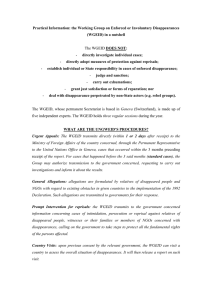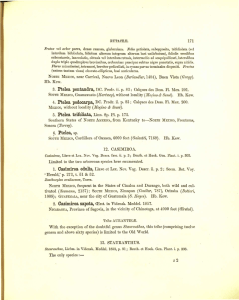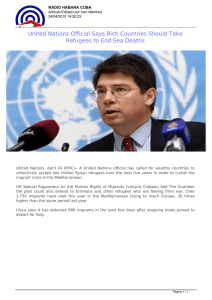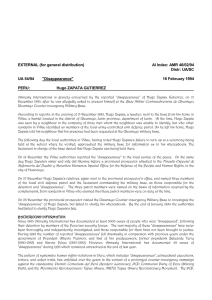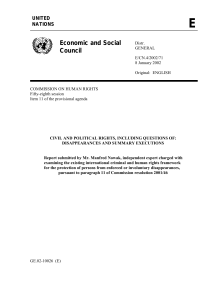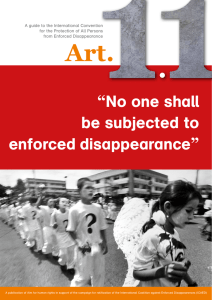Executive Summary of the Submission Presented in view of the
Anuncio
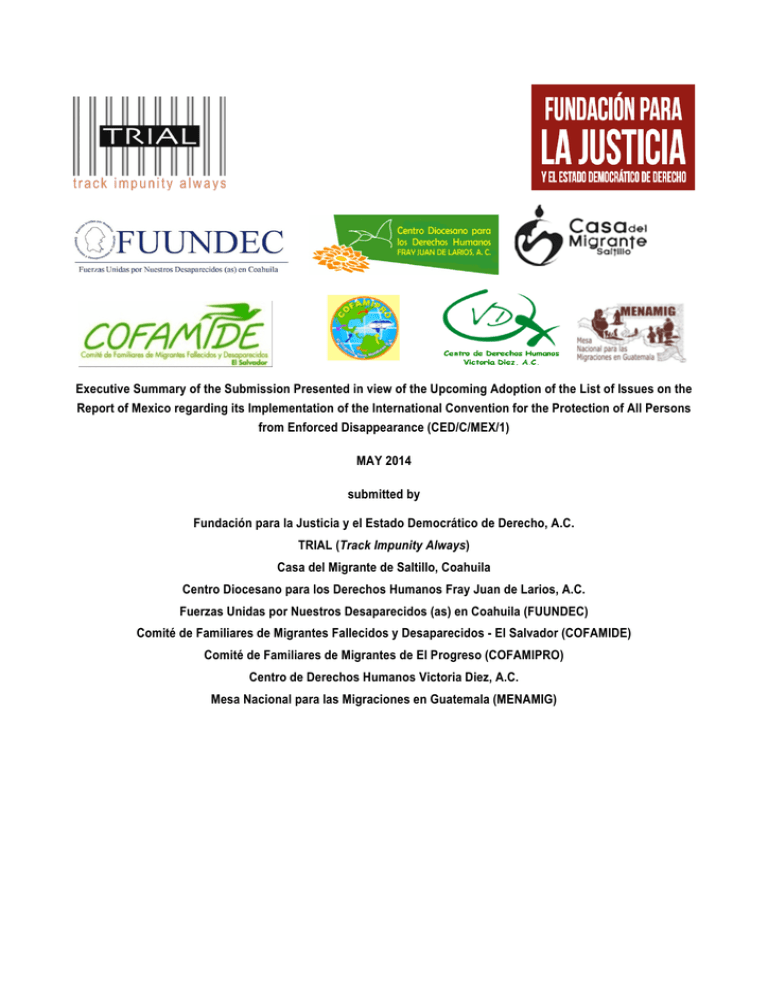
Executive Summary of the Submission Presented in view of the Upcoming Adoption of the List of Issues on the Report of Mexico regarding its Implementation of the International Convention for the Protection of All Persons from Enforced Disappearance (CED/C/MEX/1) MAY 2014 submitted by Fundación para la Justicia y el Estado Democrático de Derecho, A.C. TRIAL (Track Impunity Always) Casa del Migrante de Saltillo, Coahuila Centro Diocesano para los Derechos Humanos Fray Juan de Larios, A.C. Fuerzas Unidas por Nuestros Desaparecidos (as) en Coahuila (FUUNDEC) Comité de Familiares de Migrantes Fallecidos y Desaparecidos - El Salvador (COFAMIDE) Comité de Familiares de Migrantes de El Progreso (COFAMIPRO) Centro de Derechos Humanos Victoria Diez, A.C. Mesa Nacional para las Migraciones en Guatemala (MENAMIG) I. General Issues 1. The alternative report is submitted by a group of non-governmental organizations and it is mainly focused on the specific subject of enforced disappearance of migrants and the obstacles faced by their families. The loopholes of the existing Mexican legislation concerning enforced disappearance are also thoroughly analysed. The omission of other subjects from the report shall not be interpreted by any means in the sense that the subscribing associations consider that Mexico meets all its obligations pursuant to the International Convention on the Protection of All Persons from Enforced Disappearance (“the Convention”). 2. In this summary only an overview of the main problems analysed in the integral version of the alternative report will be provided, together with the questions that the subscribing associations encourage the Committee on Enforced Disappearances (“the Committee”) to include in the list of issues (“LOIS”) that it will adopt on the occasion of its 7th session. The integral version the report contains also a list of recommendations that the subscribing associations consider important to be addressed to Mexico by the Committee (paras. 191-192 of the integral version in Spanish). 3. The Guidelines on the form and content of reports under Art. 29 to be submitted by State parties to the Convention require that “a section of the treaty-specific report should be devoted to the process of preparation, in particular to any consultation within the Government, with national institutions for the protection and promotion of human rights, families of victims’ organizations, human rights defenders working on the issue of enforced disappearance, non-governmental organizations and other stakeholders, which might have taken place”. However, no such information was included by Mexico in its report. 4. Similarly, Mexico did not include in its report statistical data on cases of enforced disappearances disaggregated by, inter alia, sex, age, ethnic origin and geographical location. This seems to be directly related to the persisting lack of a unified register or database of disappeared persons. This makes it almost impossible to determine the exact number of victims of this crime and, as a consequence, to set up an effective search and investigation strategy. This is particularly true when it comes to migrants subjected to disappearance, because in this case Mexico and the authorities of the neighbouring countries do not count with any precise data, while all efforts are left to associations of the civil society. A Law on a National Database on Missing and Disappeared Persons entered into force, but at the time of writing no concrete efforts have been undertaken to implement such piece of legislation. For more details see the integral version of the report paras. 1-29 2 Suggested questions to be included in the LOIS II. Please provide information about the process of preparation of the report, including consultations with civil society actors and other relevant stakeholders which might have taken place. Please provide statistical data on cases of enforced disappearances disaggregated by, inter alia, sex, age, ethnic origin and geographical location, with particular attention to those relating to migrants. Please provide details on the steps undertaken to implement the Law on the National Database on Missing and Disappeared Persons. Definition and Criminalization of Enforced Disappearance (Arts. 1-7) Arts. 2, 4, 5 and 7 – Definition and Codification of Enforced Disappearance as an Autonomous Offence and Enforced Disappearance as a Crime against Humanity 5. Art. 215-A of the Federal Criminal Code contains a definition of enforced disappearance that is not in line with international standards, thus hampering the prevention, investigation and prosecution of the crime. Despite the order to amend such provision issued by the Inter-American Court of Human Rights in 2009, Mexico has failed to do so. Moreover, enforced disappearance is not codified as an autonomous offence in all the criminal codes of the different States. Where such a definition exists, it is often not in line with international law either. In particular, the definitions included in the Federal Criminal Code and in some of the States’ criminal codes fail to include the possibility that enforced disappearances are committed by persons or groups of persons acting on behalf of, with the support, consent or acquiescence of the State. Enforced disappearance is not codified as a crime in the military criminal code. Further, Mexico has not codified crimes against humanity at any level. Finally, Mexico lacks a general law on enforced disappearance. For more details see the integral version of the report paras. 30-63 Suggested questions to be included in the LOIS - Please clarify what is the current status of the decree presented on 22 October 2013 to amend paragraphs A, B and C of Art. 215 of the Federal Criminal Code and to add Art. 215 E. Please inform about the efforts undertaken to codify at the Federal level crimes against humanity. Please provide information on the pending or forthcoming initiatives to ensure that all Mexican States codify the crime of enforced disappearance in accordance with international law. Art. 6 – Criminal Responsibility 6. In its report Mexico does not provide information on what is the current regime to sanction any person who commits, orders, solicits or induces the commission of, attempts to 3 commit, is an accomplice to or participates in an enforced disappearance. On the other hand, the State recognizes admits that currently the subject of superior responsibility is not regulated under Mexican legislation, neither for isolated acts of enforced disappearance nor for crimes against humanity. Finally, Mexican legal framework does not contain any provision that expressly prohibits orders or instructions directing, authorizing or encouraging an enforced disappearance and that establishes that any person receiving such an order or instruction shall have the right and duty not to obey it. For more details see the integral version of the report paras. 64-67 Suggested questions to be included in the LOIS - - - III. Please provide information on how would any person who orders, solicits or induces the commission of, attempts to commit, is an accomplice to or participates in an enforced disappearance currently be sanctioned. Please indicate if the decree presented on 22 October 2013 to amend paragraphs A, B and C of Art. 215 of the Federal Criminal Code would change the current regime and, if so, how. Please provide information on whether there is any pending or forthcoming initiative to regulate the subject of superior responsibility in accordance with Art. 6, para. 1 (b), of the Convention and with Art. 28 of the Rome Statute for the Establishment of an International Criminal Court. Please provide information on whether there is any pending or forthcoming initiative to expressly prohibit orders or instructions directing, authorizing or encouraging an enforced disappearance and to establish that any person receiving such an order or instruction shall have the right and duty not to obey it. Criminal Responsibility and Judicial Cooperation in relation to Enforced Disappearance (Arts. 816) Art. 8 – Statute of Limitations 7. The fact that currently crimes against humanity, including the widespread or systematic practice of enforced disappearance, are not codified under Mexican legislation, determines that their imprecriptibility is not envisaged either. For more details see the integral version of the report paras. 68-69 Suggested questions to be included in the LOIS - Please clarify what is the statute of limitation for criminal proceedings concerning crimes against humanity, including the widespread or systematic practice of enforced disappearance. Please specify whether this would change as a consequence of the amendments proposed by the Federal government to the Parliament on 22 October 2013 and, in case of positive answer, what would be the change? Arts. 9, 10 and 11 – Universal Jurisdiction and the aut dedere aut judicare Principle 8. The establishment of universal jurisdiction, intended as the jurisdiction of domestic tribunals to 4 judge and sanction those responsible for enforced disappearance or international crimes that are present in the territory of the State concerned, is a bulwark against impunity. At present, Mexican legislation does not seem to spell out with the necessary clarity that Mexican tribunals could exercise their jurisdiction when a person accused of enforced disappearance or another international crime is present in any territory under Mexican jurisdiction and the State does not extradite him or her and in fact the practice of domestic judicial authorities in this sense is scarce when non-existent. Furthermore, at present legal provisions do not make it clear that the judgment of the accused is not conditional on the existence of a previous request of extradition and that it is not necessary that the offence of which the person is accused is codified both in the State where it was committed and in Mexico (so called “double criminality requirement”). For more details see the integral version of the report paras. 70-80 Suggested questions to be included in the LOIS - - Please clarify how would be dealt under the current legislation a case where a person who is present in the Mexican territory is accused to be responsible for an enforced disappearance, but the latter is not codified as an autonomous crime in the country where it was committed. Please clarify whether any provision of the current Mexican legislation explicitly establishes universal jurisdiction on cases of enforced disappearance and if there is any forthcoming initiative in this sense. Art. 12 – Obligation to Investigate 9. For relatives of migrants subjected to enforced disappearance in Mexico it is virtually impossible to report the facts to the competent Mexican authorities and to have their allegations promptly and thoroughly investigated. This is due to the fact that they live abroad and are not in a position to travel to Mexico to report the facts and Mexican authorities do not recognize them their quality as complainants, thus concretely hampering their right to justice and to know the truth. When family of migrants subjected to enforced disappearance in Mexico have tried to refer their cases to other authorities in their countries of origin (e.g. prosecutor, consular authorities or Ministry of Foreign Affairs) this has proved to no avail due to the lack of effective channels of communication and cooperation with Mexican authorities. 10. Even when an investigation is eventually opened, families of migrants subjected to enforced disappearance in Mexico experience serious difficulties in having access to information concerning the progress and results of such investigations. This often means that relatives are prevented from providing evidence or data that may be of use to determine the identity of those responsible or for fostering the process of establishing the fate and whereabouts of the 5 victims. 11. Mexico does not offer any measure to protect from ill-treatment or harassment relatives of migrants subjected to enforced disappearance in Mexico who may decide to report the facts. Given that often criminal groups are involved the commission of gross human rights violations against migrants, families may become the target of threats or attacks. In general, despite the promulgation of the Human Rights Defenders and Journalists Protection Act, and the establishment of the corresponding protective mechanism, instances of harassment, threats, and gross violations committed against relatives of disappeared persons, their relatives and their representative associations remain frequent. Moreover, in the great majority of cases where these persons have been subjected to gross human rights violations, including arbitrary executions, torture and enforced disappearance, those responsible for the crimes concerned have not been judged and sanctioned, thus fostering an overall climate of impunity. 12. Although a Specialized Unit for Searching Missing and Disappeared Persons has been established, it does not count with the necessary human and financial resources to carry out its mandate. Civil society organizations and associations of victims underscore with concern that the search of disappeared persons is so far not designed to find persons alive, but rather to locate mortal remains, while an effective “urgent action” would require a significant paradigm shift. 13. In its report, Mexico refers that currently there are six condemnatory sentences on cases of enforced disappearance. This number is alarmingly low, considering that the government itself has recognized the existence of more than 26000 cases of enforced disappearance in the last decade. In general, it is virtually impossible to have access to precise data on the number of ongoing investigations on cases of enforced disappearance and this becomes even more complicated when it comes to determining how many investigations have been launched on cases involving migrants subjected to enforced disappearance in Mexico. For more details see the integral version of the report paras. 81-107 Suggested questions to be included in the LOIS Please provide information on which measures have concretely been adopted to ensure that persons who do not live in Mexico who allege that a person has been subjected to enforced disappearance have the right to report the facts to the competent Mexican authorities. Please provide information on the existing measures to ensure that persons having a legitimate interest have access to information concerning the investigations on cases of enforced disappearance, in particular in cases concerning migrants. Please provide information on which measures have been adopted to protect relatives of migrants victims of enforced disappearance in Mexico who report the facts, in particular when 6 - - they live outside the country. In general, provide information on the existing measures to ensure that the complainant, witnesses, relatives of the disappeared person and their defence counsel, as well as persons participating in the investigation are protected against illtreatment and harassment. Please clarify on which financial and human resources does the Specialized Unit for Searching Missing and Disappeared Persons rely upon and whether any comprehensive strategy to deal with the cases received has been designed so far. Moreover, please specify whether the Unit is conceived and equipped to deal with and encompass the transnational scope of the phenomenon of enforced disappearance of migrants. Please clarify the number of investigations on cases of enforced disappearance currently pending, in particular concerning migrants. Arts. 13 and 16– Extradition and Non refoulement Although Art. 13, para. 3, of the Convention requires that States parties undertake to include the 14. offence of enforced disappearance as an extraditable offence in any extradition treaty subsequently to be concluded by them, Mexico failed to include this express mention in bilateral agreements concluded after the entry into force of the Convention. 15. At present, in Mexico at present there are no bilateral extradition agreements that expressly envisage the possibility to reject an extradition request where there are substantial grounds for believing that the person concerned would be in danger of being subjected to enforced disappearance. For more details see the integral version of the report paras. 108-111 Suggested questions to be included in the LOIS - - - Please provide information on which measures have been adopted to include the offence of enforced disappearance as an extraditable offence in extradition treaties concluded after 23 December 2010. Please provide information on the mechanisms and criteria applied within the framework of expulsion, return, surrender or extradition procedures to assess the risk of a person being subjected to enforced disappearance or the risk of other serious harm to the life or integrity of the person. Please indicate whether Mexico is party to any bilateral extradition agreements that do not expressly include the possibility of refusing an extradition request when there are substantial grounds to believe that the person may be subjected to enforced disappearance or that there is a risk of other serious harm to the life or integrity of the person. If so, please indicate what measures have been taken to ensure that the implementation of such agreements is compatible with the principle of non-refoulement. Please indicate whether diplomatic assurances can be used as a basis for proceeding with an expulsion, return, surrender or extradition. If so, please provide detailed information on the conditions under which diplomatic assurances may be used when there are substantial grounds to believe that a person may be subjected to enforced disappearance or that there is a risk of other serious harm to the life or integrity of the person. 7 Arts. 14 and 15 – Legal Assistance and International Cooperation 16. In its report Mexico informs that it has concluded a number of bilateral agreements of mutual legal assistance in connection with criminal proceedings. While this is indeed true, in the cases of enforced disappearance involving migrants, these agreements have proven ineffective. 17. In its report Mexico fails to provide any information on which measures it may have adopted to ensure mutual assistance, in particular with Central American States, with a view to assisting victims of enforced disappearance, and in searching for, locating and releasing disappeared persons and, in the event of their death, in exhuming and identifying them and returning their remains. For more details see the integral version of the report paras.112-118 Suggested questions to be included in the LOIS - - IV. Please provide information on the obstacles encountered in the implementation of the bilateral agreements of legal assistance, in particular with Central American States, in cases that concern the enforced disappearance of migrants in Mexico. Provide information on which measures have been adopted to ensure mutual assistance, in particular with Central American States, with a view to assisting victims of enforced disappearance, and in searching for, locating and releasing disappeared persons and, in the event of their death, in exhuming and identifying them and returning their remains. Please also provide examples, if any, of mutual legal assistance or cooperation in cases of enforced disappearance. Measures to Prevent Enforced Disappearances (Arts. 17-23) Arts. 17, 18, 20, and 21 – Prevention of Enforced Disappearance and Persons Deprived of their Liberty, Right to Access to Information on Persons Deprived of their Liberty and Limitations, and Release 18. Art. 17, para. 1, of the Convention establishes that no one shall be held in secret detention. This provision was included in the treaty to make it clear that States must not only codify and sanction the offence of enforced disappearance under their domestic legislation, but they must also expressly prohibit secret detention. Mexican legislation does not include such explicit prohibition and the offence is not codified in accordance with applicable international law. 19. Notwithstanding the recommendations of various international human rights mechanisms, Mexican authorities continue invoking and applying the power of “arraigo”, which allows prosecutors, with judicial authorization, to detain individuals for up to 80 days before they are charged with a crime. This practice amounts to arbitrary detention and may lead to subsequent enforced disappearance. Further, so far, the amparo action has proven to be an insufficient remedy. Although in 2013 there has 8 been a reform of the amparo procedure, it remains to be assessed whether it will bring any meaningful improvement. 20. Mexico has not yet established a unified official register of persons deprived of their liberty. This, coupled with the significant difficulties experienced by the families willing to have access to information related to detainees, jeopardizes the prevention of enforced disappearance. Special attention must be paid to migrant-holding centres (estaciones migratorias), where persons are not ensured their right to medical and legal assistance and to inform their families of origin about their apprehension and are thus particularly vulnerable to enforced disappearance. This must be seen in the light of the fact that detention of migrants in these centres exceeding 36 hours is contrary to the Mexican Constitution and must be considered arbitrary. Moreover, persons held in migrant-holding centres are seldom informed about their right to obtain a humanitarian visa in case they are victims or witnesses of a crime. For the families of persons held in migrant-holding centres, given the fact that they often live abroad, locating where their loved ones may be held, having access to information and maintaining regular contacts with them is extremely difficult and authorities are often indifferent in face of their acute anxiety. An especially grave situation, illustrative of the mentioned circumstances, is reported in the migrant-holding centre in the city of Saltillo, Coahuila. Finally, migrant-holding centres do not count with effective mechanisms to identify victims of trafficking that may be held there and to provide them with the necessary protection and assistance. For more details see the integral version of the report paras. 119-150 Suggested questions to be included in the LOIS - - - IV. Please specify which measures have been adopted to abolish the arraigo from national legislation. Please provide information on which measures have been adopted to ensure the existence of a unified register of detention and custody, where the entire chain of custody of the detained person can be traced and that is easily accessible to relatives of persons deprived of liberty and their counsels. Please provide information on which measures have been adopted to ensure access to legal assistance and communication with their families or any person of their choice of persons kept in migrant-holding centres (estaciones migratorias) in Mexico. Provide details concerning measures adopted to ensure that this persons who are in a particularly vulnerable situation, fully enjoy the guarantees enshrined in Arts. 17, 18, 20 and 21 of the Convention. Please indicate which measures have been adopted to disseminate information on the existence and functioning of the amparo proceedings, its requirements and effects, in particular in cases concerning enforced disappearance. Reparation and Measures to Protect Children from Enforced Disappearance (Arts. 24 and 25) Art. 24 – Victims of Enforced Disappearance and their Rights 9 a) The Notion of Victim of Enforced Disappearance 21. Although the General Law on Victims (2013) enshrines a definition of “victim” that is comprehensive and in line with Art. 24, para. 1, of the Convention, this definition is not always correctly applied. In particular, relatives of migrants subjected to enforced disappearance in Mexico are often denied the status of victims. This formal denial of their status represents a concrete obstacle to their access to justice, truth and reparations. b) Location, Exhumation, Respect and Return of Mortal Remains 22. Between 2010 and 2012 mass graves containing the mortal remains of hundreds of human beings were discovered in the States of Tamaulipas and Nuevo León. The mass graves correspond to three massacres (known as “the massacre of 72 migrants in Tamaulipas”, “the 49 common graves of San Fernando”, and “the 49 trunks of Cadereyta”) where mainly migrants were killed and mutilated. A significant progress is represented by the establishment of a Forensic Commission in August 2013. This Commission, based on an agreement among the Office of the Attorney General of Mexico (Procuraduría General de la República - PGR), civil society organizations and the Argentine Forensic Anthropologic Team (EAAF) will be in charge of identifying the mortal remains found in the mass graves concerning the three mentioned massacres. Despite this positive development, it is necessary to point out that new mass graves have been discovered and that the number of mortal remains to be exhumed and identified continues increasing. Outside the framework of the mentioned agreement leading to the establishment of the Forensic Commissions, exhumations are characterized by irregularities and mistakes. Cases of erroneous identifications have been registered, as well as instances where the remains were cremated without the consent of the family. These incidents, coupled with the lack of credible information from authorities, have inflicted deep suffering and frustration to the families of the victims. The latter, in particular when residing abroad, have been further marginalized and harmed by the fact that their status as victims has not been duly recognized in the processes before Mexican authorities which, moreover, seem to lack a scheme of effective cooperation on these matters. c) The Right to Compensation and to Integral Reparation 22. Although the enactment of the General Law on Victims represents a significant step forward also in this domain, the implementation of this new piece of legislation is still inadequate. Furthermore, to the knowledge of the associations subscribing the report, at present Mexico does not count on a specific programme aimed at granting integral reparation to migrants who are victims of gross human rights violations and their families. This gap is the source of deep concern, given the scope and the specificities of the phenomenon, which requires to be promptly and 10 adequately addressed. 23. After three years and four months, on 23 December 2013 the National Human Rights Commission eventually issued a recommendation concerning the massacre of 72 migrants in San Fernando, Tamaulipas. While the long-awaited recommendation is certainly welcome, it is a source of concern that relatives of the victims have not been involved in the process in any way. They have neither been consulted by the National Commission, nor were they placed in a position to make their voices heard. The fact that the recommendation does not qualify the massacre as a case of “gross human rights violations” sounds for many of the relatives as a mockery. All the more so when in its recommendation the National Commission fails to establish whether violations of the rights to life and to personal integrity have been committed. Finally, contrary to international standards and to the Mexican General Law of Victims, relatives are not considered as victims in the recommendation. This demonstrates a lack of understanding of the scope of the crime at stake and its consequences and implications, and hampers the rights to truth and reparations. d) Measures to Regulate the Legal Situation of Disappeared Persons 24. At present Mexican legislation does not contain specific measures (such as the “declaration of absence due to enforced disappearance”) to regulate the legal situation of disappeared persons whose fate has not been clarified in fields such as social welfare, financial matters, family law and property rights. Relatives are therefore forced to obtain “declarations of death”, which, given the specific nature of enforced disappearance results a form of ill-treatment and is highly re-traumatizing. For more details see the integral version of the report paras. 151-188 Suggested questions to be included in the LOIS - - Please provide information on the measures adopted to recognize the status of “victims” to the relatives of migrants subjected to enforced disappearance in Mexico. Please clarify which measures have been adopted to locate, respect and return the mortal remains of victims of enforced disappearance who died, in particular in the case of migrants. Please provide information on which measures have been adopted to ensure the respect of the mortal remains of persons subjected to enforced disappearance and to avoid their cremation, in particular when the families opposed to such cremation and the latter was contrary to their religious beliefs. Please clarify if those who wish to appeal against a resolution of the National Human Rights Commission have any effective remedy to do so. Please explain how can relatives of migrants subjected to enforced disappearance in Mexico concretely access measures of reparation established pursuant to the General Law on Victims. Please provide concrete information on the measures adopted to guarantee compensation or rehabilitation to victims of enforced disappearance, and include updated information on the nature of programmes of assistance and support to victims that may have been carried out to date 11 - and how many victims concretely benefitted from such programmes. Please specify whether Mexican legislation envisages the notion of “declaration of absence of enforced disappearance”. Otherwise, how is the status of disappeared persons regulated in fields such as social welfare, financial matters, family law and property rights? Art. 25 – Special Protection of Children Victims of Enforced Disappearance 25. The report presented by Mexico does not contain any information on whether Mexican legislation codifies and sanctions the offences of wrongful removal of children who are subjected to enforced disappearance, children whose father, mother or legal guardian is subjected to enforced disappearance or children born during the captivity of a mother subjected to enforced disappearance; or the falsification, concealment or destruction of documents attesting to the true identity of the children concerned. 26. The report presented by Mexico does not inform either on whether the State counts on a legal procedure to review the adoption or placement procedure and, where appropriate, to annul any adoption or placement of children that originated in an enforced disappearance. For more details see the integral version of the report paras. 189-190 Suggested questions to be included in the LOIS - Please provide information on whether Mexican legislation codifies and sanctions the offences of wrongful removal of children who are subjected to enforced disappearance, children whose father, mother or legal guardian is subjected to enforced disappearance or children born during the captivity of a mother subjected to enforced disappearance; or the falsification, concealment or destruction of documents attesting to the true identity of the children concerned. - Please clarify whether Mexico has a legal procedure to review the adoption or placement procedure and, where appropriate, to annul any adoption or placement of children that originated in an enforced disappearance. 12
